Outside's long reads email newsletter features our strongest writing, most ambitious reporting, and award-winning storytelling about the outdoors. Sign up today.
Outdoor enthusiasts are more subject than most to having to deal with a vehicle breakdown in a remote location where immediate help may not be available. Since tire punctures are by far the most common problem a vehicle will experience—and something more likely to happen on dirt roads—and since you can’t always count on your spare tire, it makes sense for us to arm ourselves with the tools and knowledge it takes to repair them ourselves. Here’s how.
How Do You Know You’ve Got a Puncture?On a paved road, if your steering wheel starts to wobble vaguely in your hands, or if you hear a loud thumping sound that coincides with your wheels’ rotation, then you’ve got a flat tire. Off-road, at lower speeds, you’ll likely hear that thumping before you feel it.
In both cases, avoid risking further damage to the tire or vehicle by finding the first safe location to pull off the road or trail.
Video loading...
Don’t Rely on Your SpareIt’s become less and less common for new vehicles to come equipped with a full-size spare tire. Space savers, or donuts, are only designed to get you a very short distance at very low speeds—across town to the tire shop, basically. You should avoid using a space saver on a dirt road or trail if at all possible.
And even if you have a full-size spare with a matching tire and wheel, it’s still possible to puncture more than one tire at a time. And man, that’s going to cause a big problem if you’re not prepared or if it happens somewhere you can’t easily call for help.
What You NeedThe tools you should have to fix a flat tire yourself don’t cost much more than getting a tire plugged at a tire shop. And they’re hundreds of dollars cheaper than calling for a tow. They’re also small and light. There’s really no excuse for not carrying this stuff in your car or truck.
There’s really no excuse for not carrying this stuff in your car or truck.
The best tire-repair kit I’ve found is made by Boulder Tools and costs $38. Like other kits, it includes rope plugs and the tools you need to install them, but this one goes above and beyond by including items like needle-nose pliers, spare valve cores, and a folding razor blade.
You will also need a compressor. That’s what you’ll use to reinflate your tire after you fix the puncture, or how you’ll air back up to road pressures if you’re airing down for off-road driving. If all you need is an emergency option, one of these $23 Slime compressors is perfect. It plugs into your cigarette lighter (or 12-volt outlet), so you don’t even need to open your hood. You don’t want to rely on something like this if you’re regularly inflating oversize off-road tires, but that’s a story for another time.
I also stick a can of Fix-a-Flat in every car my family owns, plus those of most of my friends. Fix-a-Flat includes both a sealant and compressed air in a single can, allowing you to take care of the kind of small punctures caused by a screw or nail without even removing the wheel. And that capability makes it a unique tool in your arsenal—one that can come in handy for even complicated repairs where it’s not safe to to try and remove a wheel or where gaining the ability to roll the car a few hundred yards can make the situation much safer (think: a steep slope off-road or the side of a busy highway, with trucks rushing past just feet away).
Fix-a-Flat includes both a sealant and compressed air in a single can, allowing you to take care of the kind of small punctures caused by a screw or nail without even removing the wheel. And that capability makes it a unique tool in your arsenal—one that can come in handy for even complicated repairs where it’s not safe to to try and remove a wheel or where gaining the ability to roll the car a few hundred yards can make the situation much safer (think: a steep slope off-road or the side of a busy highway, with trucks rushing past just feet away).
Everyone should also carry a quality tire-pressure gauge. Use it to check the pressure of your tires once a month, and adjust them to factory-recommended settings if they’re off. Ambient temperatures, elevation, and just time can all cause a tire to lose or gain pressure, and when it does so, it can harm your fuel economy, handling, and performance.
Avoid TroubleRegularly inspect your tires and replace them before the tread wears to 2/32nd of an inch deep.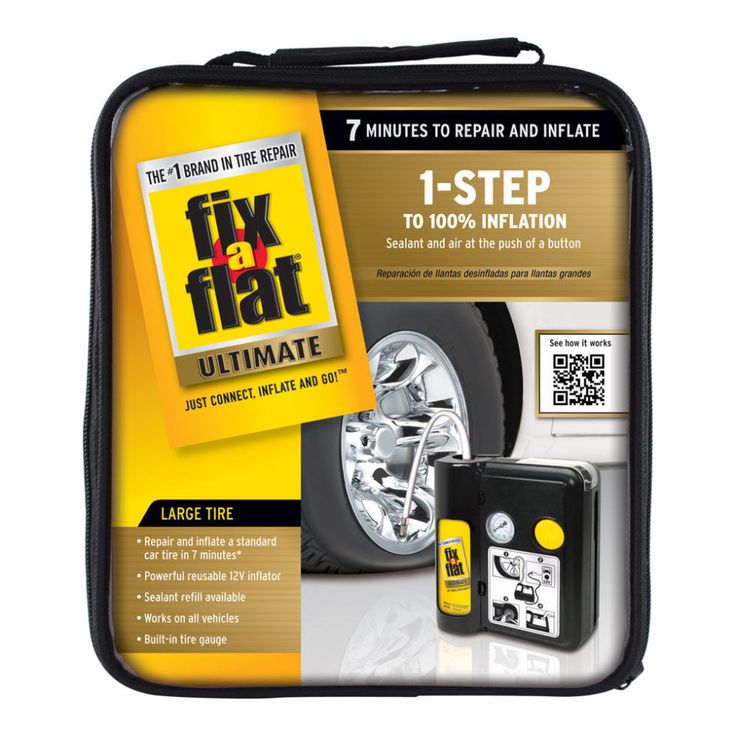 An easy way to check this is to insert a penny upside down into the tread (Lincoln’s head first). If the tread reaches past Honest Abe’s hairline at his forehead, you’re good. If not, order new tires. Tires worn to or past 2/32nd of an inch of tread will be much more prone to punctures and won’t provide the same grip as a tire in good condition.
An easy way to check this is to insert a penny upside down into the tread (Lincoln’s head first). If the tread reaches past Honest Abe’s hairline at his forehead, you’re good. If not, order new tires. Tires worn to or past 2/32nd of an inch of tread will be much more prone to punctures and won’t provide the same grip as a tire in good condition.
Tires also have a maximum life span of six years. To determine how old your tires are, look for the tire identification number on the sidewall: it begins with DOT, is 11 digits long, and ends in four numbers. The first two digits of those last four numbers represent the week (of 52 in a year) the tire was manufactured. The last two are the year.
If your tire shows any signs of cracking or tearing, or if anything white or metallic has worn through the rubber, replace it immediately.
You also need to make sure you’re using an appropriate tire for the conditions you’re facing. If you’re traveling off pavement, a quality all-terrain tire will help you avoid punctures both in the tread and, more importantly, the sidewall.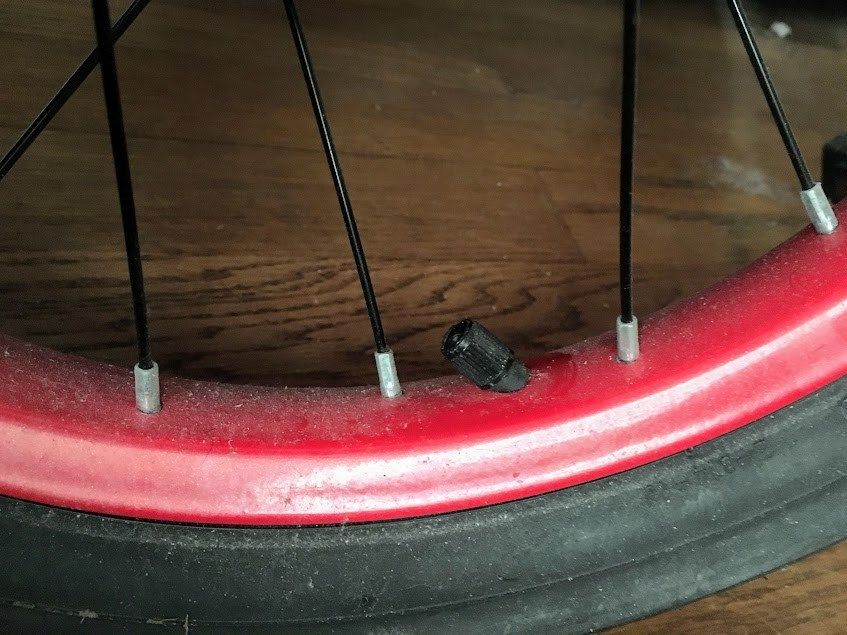
Make sure any vehicle you’re driving has all of the necessary tire-change tools present and accounted for. You’ll need a lug wrench and a jack at a minimum. Don’t be that person who forgets to put them back into a car. I even check for these things in rental cars before driving off—they’re that essential.
Right in the middle of your tread is a good place to find a foreign object. (Nathan Norby)Step One: Find the PunctureOnce you’re in a safe place, hop out of the car, and find the flat tire. Try to identify the source of the puncture. Sometimes a foreign object will be very obvious at just a glance. Sometimes you’ll need to roll the car a foot or two to expose the problem.
If you are able to see that there’s obviously a nail or screw embedded in your tire’s tread, that’s good news. If the nail or screw is strongly embedded into the tire’s tread, there’s no need to remove it at this time. Get out your can of Fix-a-Flat, follow its directions to connect it to your tire valve, and empty the entire contents of the can into the tire.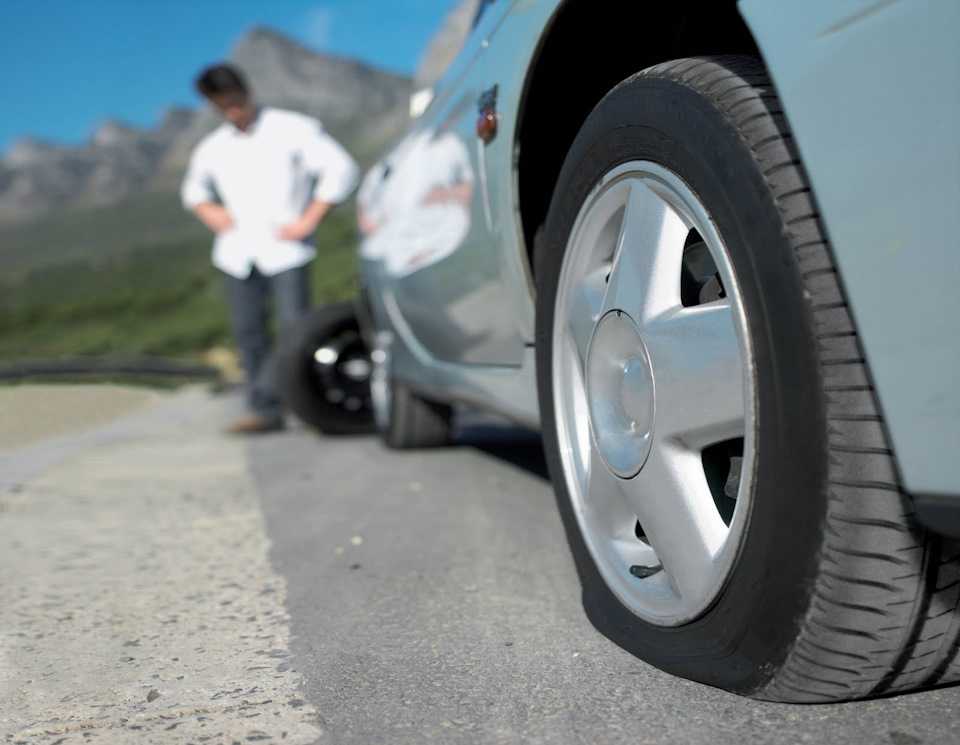 You should see the tire visibly inflate. If it returns to normal, drive off immediately, go a few miles, then stop and check your tire pressure, adjusting it if necessary. If the tire seems to be holding air, you’re good to continue driving, but take a look at the tire any time you stop. When you get back from your trip and have the time, go ahead and follow the rest of the steps here to repair the puncture with a plug.
You should see the tire visibly inflate. If it returns to normal, drive off immediately, go a few miles, then stop and check your tire pressure, adjusting it if necessary. If the tire seems to be holding air, you’re good to continue driving, but take a look at the tire any time you stop. When you get back from your trip and have the time, go ahead and follow the rest of the steps here to repair the puncture with a plug.
If you can’t find the source of the puncture, if it’s an exposed hole, or if you don’t have a can of Fix-a-Flat, you’ll need to take the wheel off.
Step Two: Remove the WheelFirst, remove your spare (even if it’s a space saver), and place it under the frame of your vehicle in front of the front tire or behind the rear tire. That way, if your vehicle falls off its jack, it will fall onto the spare, minimizing injury to you and damage to the car.
Loosen the lug nuts before you raise the vehicle. Remember: lefty loosey.
Next, follow the instructions in your owner’s manual to locate and use the jack accordingly.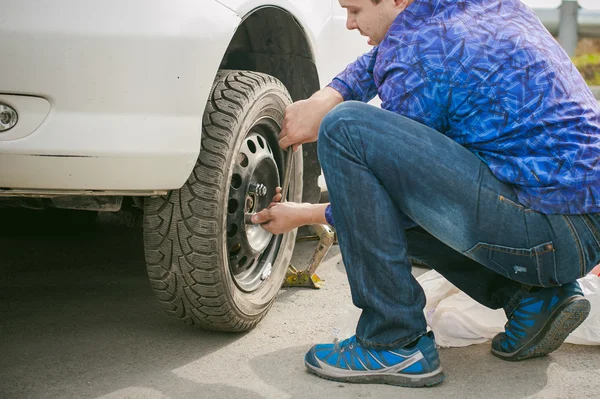
Once the wheel is off the ground, finish removing the lug nuts. Put them somewhere safe. Pull the wheel out toward your body. Be careful—wheels can be heavy.
Step Three: Evaluate the PunctureIf you have a hole in your tread, it can be fixed. Tires in good condition won’t experience more than a simple hole in that location. If the hole is in your sidewall (the portion of the tire that rides roughly vertical), you just need to mount your spare and have the tire replaced at the first possible opportunity.
If the hole is in the tire’s tread and can’t be taken care of by simply dumping a can of Fix-a-Flat into it, roll the tire around to the back of your vehicle where tools are and where you can safely work away from traffic. Look for holes and foreign objects as you roll it. If a hole is small and the tire is no longer leaking air, it may be a good idea to mark the hole for easy reference later.
The recommended kit includes these needle-nose pliers; otherwise, a multitool is a good stand-in.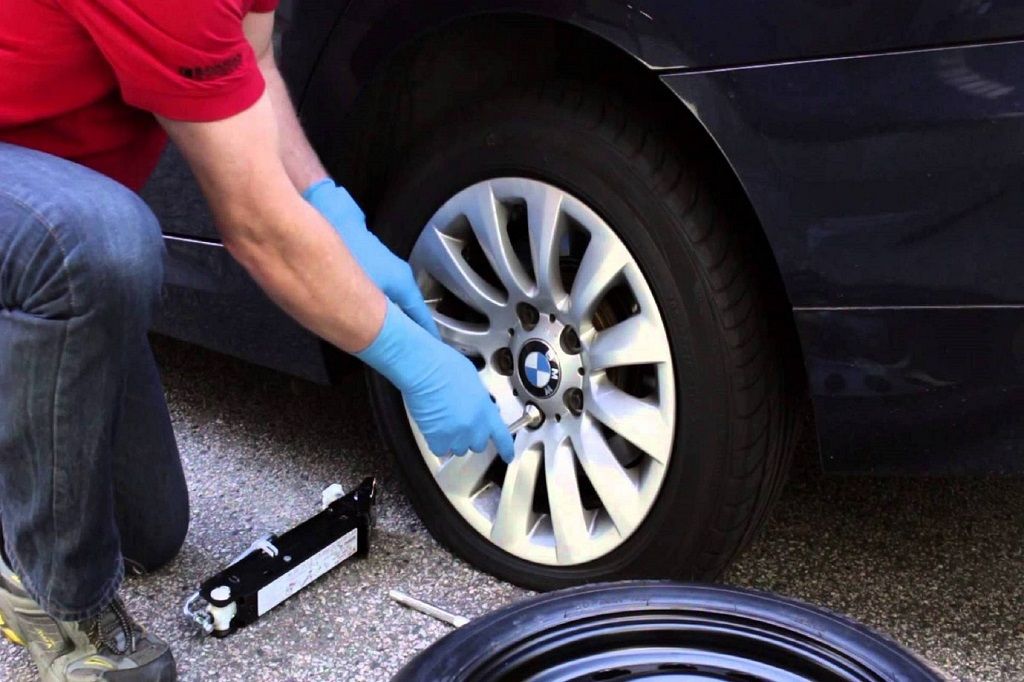 (Nathan Norby)Step Four: Remove the Problem
(Nathan Norby)Step Four: Remove the ProblemIf there’s a foreign object in your tire, and the tire can no longer hold air, remove it. In the video, I used a screw gun to put the screw in the tire, meaning its threads engaged with the rubber and steel belts. Most roads don’t have their own screw guns, so the puncture won’t engage the threads in the same way, and it should be easier to pull out using your needle-nose pliers.
I’ve seen tires punctured by everything from a steel bar to a particularly nasty cactus barb. Organic objects like tree branches can leave residue behind. Try and get all of that out of the way.
The reaming tool will slowly enlarge and clean the hole. (Nathan Norby)Step Five: Enlarge the HoleIf the hole is larger than a pencil, skip this step. If not, grab your tire-repair kit’s reamer, and use it to enlarge the hole until it is roughly the size of a pencil.
If you have a very small hole, this will be difficult at first. Install the reaming tool by slowly screwing it into the tread while applying downward pressure. Otherwise, just push the tool into the hole all the way up to the handle, then yank it out. Repeat until the hole is large enough that you can insert and remove the tool without much effort.
Install the reaming tool by slowly screwing it into the tread while applying downward pressure. Otherwise, just push the tool into the hole all the way up to the handle, then yank it out. Repeat until the hole is large enough that you can insert and remove the tool without much effort.
Remove a rope plug from the plastic wrapper, flatten one end with the needle-nose pliers, and push it through the eyelet on the installation tool. Grasp the protruding edge of the plug with the pliers, and pull it through the eyelet until equal lengths of the plug protrude from both sides.
Grab a finger of lube from the kit, and apply it to the plug and leading edge of the tool.
Firmly push the installation tool in as far as it will go, then yank it out as hard as you can.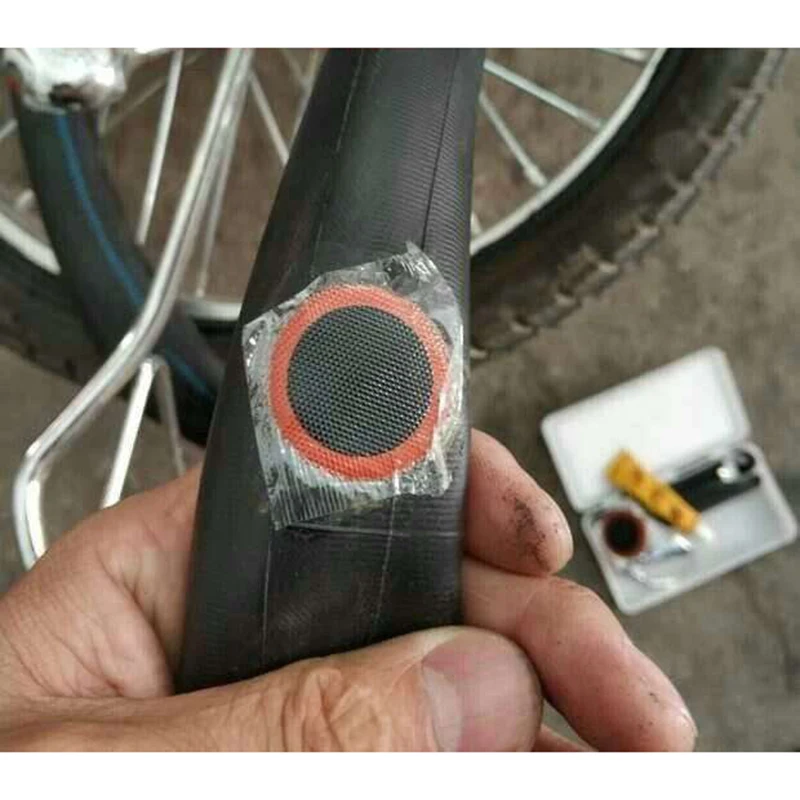 (Nathan Norby)
(Nathan Norby)Place the tool tip down on top of the hole in the tire, grasp the tool securely with both hands, and force it through the tire until the depth guide is flush with the tread. Then yank the tool straight out of the hole as hard and fast as you can. The rope plug should pass through the eyelet and remain inside the tire.
The plug should remain in the tire when you yank the tool out. Now just trim off that excess length. (Nathan Norby)If you have only a small puncture, one plug should do. If not, you may need to install a second or third. If you must install multiple plugs, then plan on taking that tire to a shop the first possible opportunity, where it can be evaluated for safety. You may have to replace it. But most of the time, that single plug will be enough. Use the razor to trim the excess length flush with the tire tread.
If your tire holds air up to the recommended pressure, then odds are it’s going to be good to go. Just check the pressure again after a few miles to make sure. If for some reason you’re losing a little air around the plug, try adding Fix-a-Flat. (Nathan Norby)Step Eight: Reinstall the Wheel
If for some reason you’re losing a little air around the plug, try adding Fix-a-Flat. (Nathan Norby)Step Eight: Reinstall the WheelUse your air compressor to inflate the tire to the recommended pressure. (You’ll find that listed inside the driver’s doorjamb.) Once inflated, reverse the tire-removal steps described above to reinstall the wheel. First, install the lug nuts by hand to secure the wheel to the hub. Then, once you’ve lowered the vehicle back down and removed the jack, use the lug wrench to make sure all the lug nuts are as tight as possible. Tighten them in a star pattern, so the wheel snugs back to the hub evenly. Remember: righty tighty. Check these again later that day.
Return all your tools, the jack, and the lug wrench to their proper locations. You’d don’t want to misplace this stuff.
And that’s it. No tow truck. No hiking out a dirt road in search of help. No waiting on AAA while sitting on the side of a busy highway. No huge expense. And no more than a few minutes of hard work.
And no more than a few minutes of hard work.
In a previous blog, we went through each of the steps necessary to change a flat tire. But what do you do when you open the trunk and find that your spare is flat, too? Or what if in a series of unfortunate events, your spare is punctured shortly after you put it on?
No matter what situation you may find yourself in, it's never a bad idea to have another trick up your sleeve; another way to fix a flat tire when a spare isn't available. Fortunately, there are two methods that are simple, cheap, and effective. Read on as we show you what to do if you have a flat and no spare!
Imagine this: You're on a road trip with the family (and the dog) and you stop at the gas station for a much-needed snack. As you walk back to the car, hotdog in hand, you notice something strange on your front tire - it's the dreaded silvery glimmer of a nail. What's more, the tire looks like it's deflating and sooner rather than later, you'll have a full-blow flat.
What's more, the tire looks like it's deflating and sooner rather than later, you'll have a full-blow flat.
As the children grow restless and the dog loses its patience, you think through your options. Unfortunately, the spare tire isn't one of them - it's flat, too. Now what? In most cases, roadside assistance would be the best option, but the whole family can't ride in the tow truck to the tire shop and you don't want to leave them with the dog in the parking lot.
Fortunately, you read a blog somewhere that helped you put together a roadside emergency kit. You fish it out of the vehicle and sift through it to find exactly what you need to get back on the road.
So, what was it you found in your kit that saved the day? There are two main tools you can use to temporarily fix your flat without changing the tire completely (assuming your tire isn't totally ruined): puncture sealant and a tire patch kit.
Regardless of which tool you have on hand, the first step is locating the puncture site.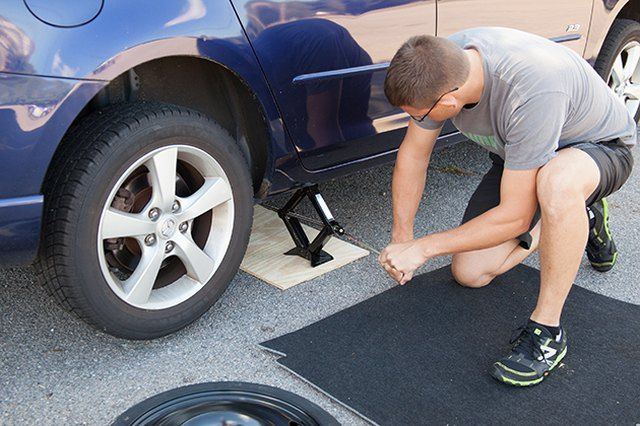 Of course, this won't be particularly difficult if you ran over something like a nail, but finding a hole in a punctured tire isn't always so easy. To locate the source of the leak, try the following:
Of course, this won't be particularly difficult if you ran over something like a nail, but finding a hole in a punctured tire isn't always so easy. To locate the source of the leak, try the following:
Visual inspection. First, you can look over the tire to try and find any obvious punctures or foreign objects (like nails).
Listen. If you don't see anything right away, bring your ear close to the tire and listen for a faint hissing sound.
Feel. Sometimes, an otherwise invisible puncture can be found by holding your hand just above the tire to feel for the leaking air.
Soap and water. If all else fails, try the soap and water method. Fill a bucket with water and add dish soap. Then, carefully coat the outside of the tire until it is covered in suds, either by hand or a spray bottle if you have one. Wait for the leaking air to create a small frothy patch of bubbles - you've found the leak! Mark it and then wash the soapy water away.
Of course, if you find yourself with a flat on the side of the road, you may not have soap, water, and a bucket on hand. However, if you're near a gas station or grocery store, you may be in luck. All you need is a water bottle (or any plastic bottle) and hand soap from a restroom. Simply add the soap to the water in the bottle, shake it up, and gently pour and spread it over your tire!
Now that you've found the leak, let's look at the two most common ways you can fix it.
There are a number of different products on the market that can seal a puncture, and they fall into two main groups. Some brands are a gel-like substance that hardens around the puncture. These products can work well, but they usually require other tools to effectively apply and can be quite messy.
The more common puncture sealant products come in an aerosol can, and don't require anything additional. For our purposes, we'll be focusing on this variant. While the specific directions may vary from product to product, they generally work in a similar fashion.
While the specific directions may vary from product to product, they generally work in a similar fashion.
The aerosol cans typically contain a foam or liquid sealant along with extra air. You attach the can to the tire's valve stem with the tube provided and fill it with the sealant, which presumably covers the puncture from within before hardening. Obviously, these products aren't going to fix major punctures or gashes, but they can be a great temporary solution.
Before using a puncture sealant product, make sure to read the can for product-specific instructions. They'll likely look something like this:
Step 1: You'll first need to remove any foreign objects, like a nail, with a pair of pliers.
Step 2: Position the tire with the valve stem at the top.
Step 3: Attach the nozzle on the can of sealant to the valve stem.
Step 4: Press the button and allow the fluid to enter.
Although the can comes with a little extra air, you'll likely need to add more air after the sealant becomes firm. Once you've allowed the sealant time to dry, you can use some of your soapy water to make sure it has done its job and stopped the leak.
Once you've allowed the sealant time to dry, you can use some of your soapy water to make sure it has done its job and stopped the leak.
So how long can you drive with a tire that has been fixed with tire sealant? Although it depends on the product, some manufacturers say you can drive for up to 100 miles. However, most experienced experts will tell you that that estimate isn't realistic, and it certainly isn't advised. Again, tire sealant solutions are meant to be temporary, emergency measures rather than a permanent fix. For that reason, you should make a tire shop your next stop.
That having been said, these little cans can be just the thing you need in a pinch. They're small and inexpensive, so you can potentially keep several in your emergency kit.
A tire plug kit is another tool you can use to temporarily fix a flat until you can replace the tire with a new one. You'll find that there are all sorts of different kits that range from the most basic tools to a collection of implements for every possible scenario. However, the fundamental components you'll need to plug a flat tire are as follows: a rasp tool, a threading tool, the plug itself, and cement or sealant.
However, the fundamental components you'll need to plug a flat tire are as follows: a rasp tool, a threading tool, the plug itself, and cement or sealant.
Some of the larger, more extensive kits will come with pliers to remove foreign objects, a knife to trim the excess portion of the plug, and even work gloves to protect your hands while you make the repairs. While you can get by with the basic components, you'll probably want to have the other items at your disposal anyway. If you don't have them in your roadside emergency kit, it's a good idea to find a tire plug kit that comes with all of the above.
Step 1: First, you'll likely need to remove the tire. This may not be necessary in every case, but you need to be able to have direct access to the puncture point. If your tires are larger, or if the tires take up too much space within the wheel well, you may not have the clearance needed until the wheel is off. For more detailed instructions on how to remove your tire and wheel with a jack and a lug wrench, read our previous blog, "How to change a flat tire in four simple steps. "
"
Step 2: If the object that punctured your tire is still in place, use your pliers to remove it.
Step 3: Use the rasp tool to clean the puncture hole. The rasp tool is a long, pointed piece of metal with a rough, textured end. By quickly running it and out of the puncture, it helps make the hole more uniform, cleaning away stray pieces of rubber, but also providing a rough texture for the plug to grip on to.
Step 4: The insertion tool should look like a long, thin piece of metal with an eyelet at the end (like the head of a really large sewing needle). Thread the plug through the eyelet, and then firmly press the plug into the hole using the insertion tool. Some kits come with a glue, cement, or adhesive product, which you'll want to apply to the plug prior to insertion. Depending on your kit, there should be some portion (like 1/4 - 1/2 inch) of the plug protruding from the hole after insertion.
Step 5: Cut away the excess portion of the plug using your knife.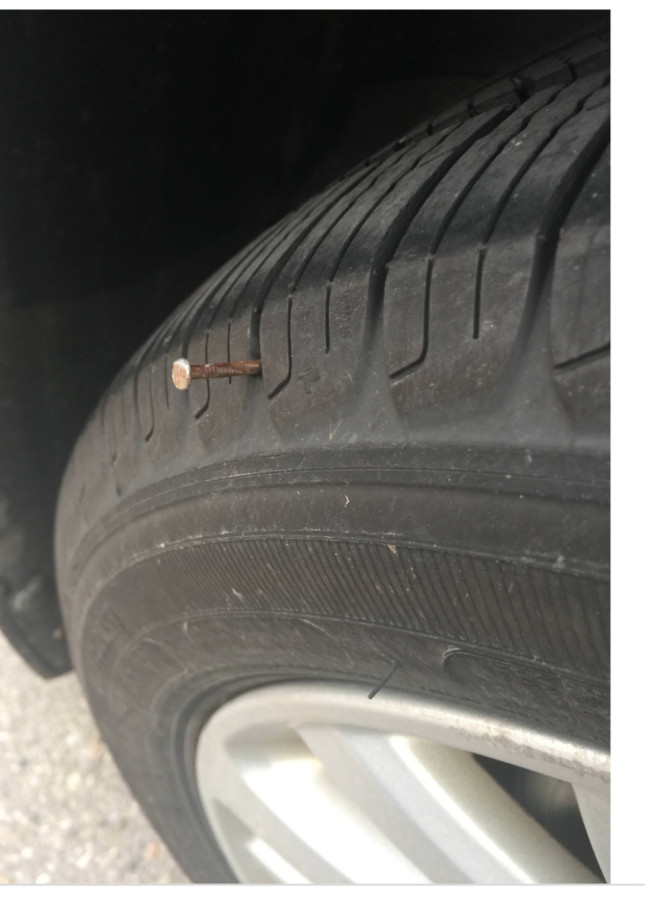 Then, apply a layer of adhesive over the top to seal it in place and cover any small cracks.
Then, apply a layer of adhesive over the top to seal it in place and cover any small cracks.
Step 6: Wait for the adhesive to dry, then apply some of your soapy water to the plug site to test for leaks and fill them in with adhesive if necessary.
Step 7: Before replacing the tire, inflate the wheel to ensure that the plug and seal holds. If it does, you can now place the tire back on the vehicle, fasten it in place with the lugnuts and finish inflating.
How long can you drive with a tire plug? Unlike tire sealant, plugs can potentially last for hundreds of miles, or even years after you apply it. Of course, this depends on the plug, the type and location of the puncture, and how well the plug was installed. Furthermore, depending on the cause of the puncture, your tire may be more prone to flats and blowouts in the future.
No matter what the cause of your flat is, or what method you choose to fix it, the safest option is to visit your local tire shop as soon as possible. It can be easy to forget about your tires when you're going through your list of auto maintenance tasks. However, taking care of your tires through routine tire maintenance is the best way to avoid flats in the future.
It can be easy to forget about your tires when you're going through your list of auto maintenance tasks. However, taking care of your tires through routine tire maintenance is the best way to avoid flats in the future.
Fixing a flat tire isn't always simple and sometimes, you need a helping hand. When you add Germania's Roadside Assistance Service to your personal auto policy, help is never far away!
Visit our website to learn more about Germania's Auto Insurance products!
Read more: Replacing a tire can be expensive, but your auto insurance doesn't have to be! Check out our blog to learn which auto insurance discounts you should look out for!
90,000 here are you yourself (and you can’t) - the magazine for the wheel ofLADA
UAZ
KIA
Hyundai
Renault
Toyota
Volkswagen
Skoda
Nissan
BM -Benz
Mitsubishi
Mazda
Ford
All brands
Most often, we ourselves are to blame for the fact that tires become unusable. But this can be avoided.
But this can be avoided.
Related materials
You have never seen such tires: even the police were surprised
In the process of using a tire, a variety of damages can occur, most of which are the fault of the driver. As a result, rubber is wasted, and since the law prohibits the use of different tire models on the same axle, you have to spend money on replacing the second tire.
The most common damage is puncture . This is the most harmless type of damage, but only if you notice it in time and repair it right away. It is absolutely impossible to drive on a flat tire, even a couple of meters! The damage caused by running on a flat tire or with low pressure is catastrophic. This causes the sidewalls to deform more than they should, which causes the tire to overheat, delaminate, and the carcass becomes unusable due to broken cords. As a result, the tire will have to be thrown away. In addition, the edge of the rim can also be damaged.
Punctures are of two types: with and without cord damage. To determine this, it is necessary to remove what pierced it. If the edges of the puncture tightly converge, then the cord is not damaged and it will be possible to repair the tire without removing it from the disk. Otherwise, if the edges do not converge, you will have to disassemble the wheel and make repairs with strengthening the frame from the inside. Alternatively, in the field and in the absence of a spare wheel, such a puncture can be repaired without removing the tire from the rim, after which you can carefully drive to a tire fitting or garage and make a full repair.
Related materials
Is it possible to pump up a wheel without a compressor - the experiment "Behind the wheel"
When repairing, the puncture site should be cleaned and marked. Further, it all depends on what kind of repair kit you have - as a rule, instructions are attached to them. There are sealants that are poured into the tire through the nipple, after which the wheel turns with the puncture down and the substance seals the hole. Repair using a tourniquet or insert is somewhat more complicated, but also more durable: the edges of the hole are polished with a special tool, after which the tourniquet treated with a special compound must be inserted into the tire through a puncture with a special awl, pulled out (not completely) out and cut flush with the surface.
Repair using a tourniquet or insert is somewhat more complicated, but also more durable: the edges of the hole are polished with a special tool, after which the tourniquet treated with a special compound must be inserted into the tire through a puncture with a special awl, pulled out (not completely) out and cut flush with the surface.
In case of damage to the cord due to a puncture, the tire must be removed from the rim in order to install a reinforced patch with an additional cord on its inner surface. One of the sides of such patches has an adhesive layer that promotes cold vulcanization. After such a repair, wheel balancing will be required. To seal punctures from the inside, patches in the form of a mushroom are also used, with a leg that goes into the puncture. Such patches are also covered with a special adhesive for cold vulcanization.
Cuts or holes , unlike punctures, are not repairable, as they violate the integrity of the frame, which can no longer be strengthened. In addition, breakdowns are always sudden and occur on the go: the tire abruptly loses pressure and before the car comes to a complete stop it has time to make several revolutions “on the rims”, which breaks the cord and destroys the layers. It is not recommended to use such a weakened tire, even if it was possible to repair and strengthen the place of the rupture or cut, in the future.
In addition, breakdowns are always sudden and occur on the go: the tire abruptly loses pressure and before the car comes to a complete stop it has time to make several revolutions “on the rims”, which breaks the cord and destroys the layers. It is not recommended to use such a weakened tire, even if it was possible to repair and strengthen the place of the rupture or cut, in the future.
Related materials
8 tire storage rules - do you follow them all?
Incorrect storage of tires can cause cracks . The danger of such damage is that moisture enters the cord through cracks, which renders the frame unusable. In addition, air can escape through cracks. Unfortunately, cracks are not repairable, and tires with them will not last long: sooner or later they will deform, become covered with swellings due to rusted and torn cord or because of driving with pressure below the recommended one.
Blisters or bulges can appear on a tire for a variety of reasons - it always happens due to a broken cord or delamination in the carcass.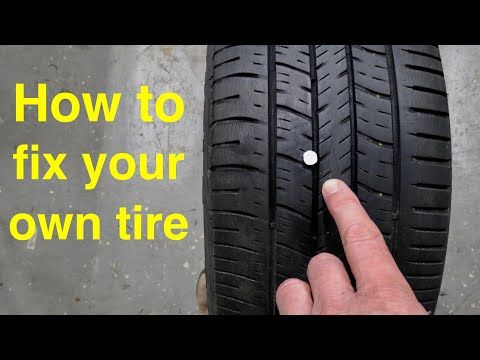 In the first case, an obstacle was hit and the impact broke the cord or the cord was cut through with a sharp object. In the second case, there is no damage on or near the hernia, which means that it appeared either due to a factory defect, or due to frequent driving with pressure below the recommended one. The danger of hernias is that they can explode at any moment and provoke a skid, which will lead to an accident. If there is nothing to replace a tire with a hernia, then it is better to rearrange it to the rear axle and drive very carefully. Like cracks, a hernia cannot be repaired. Sometimes small blisters resulting from impacts or cuts are reinforced with reinforced patches, but there is no guarantee that the tire will not explode. Therefore, tires with hernias are recommended to be replaced immediately.
In the first case, an obstacle was hit and the impact broke the cord or the cord was cut through with a sharp object. In the second case, there is no damage on or near the hernia, which means that it appeared either due to a factory defect, or due to frequent driving with pressure below the recommended one. The danger of hernias is that they can explode at any moment and provoke a skid, which will lead to an accident. If there is nothing to replace a tire with a hernia, then it is better to rearrange it to the rear axle and drive very carefully. Like cracks, a hernia cannot be repaired. Sometimes small blisters resulting from impacts or cuts are reinforced with reinforced patches, but there is no guarantee that the tire will not explode. Therefore, tires with hernias are recommended to be replaced immediately.
Related materials
Tire blackening - 6 ways to polish. Inexpensive!
Tire sidewalls can be damaged by rubbing against curbs or the asphalt edge when pulling over. If you are prone to such a driving style, then it is recommended to inspect the inner and outer sidewalls from time to time and, if abrasion is found, swap the wheels in order to prevent the cord from being exposed - the rubber thickness on the sidewalls is small (1.5–3 mm), and it can be rubbed to the frame very quickly.
If you are prone to such a driving style, then it is recommended to inspect the inner and outer sidewalls from time to time and, if abrasion is found, swap the wheels in order to prevent the cord from being exposed - the rubber thickness on the sidewalls is small (1.5–3 mm), and it can be rubbed to the frame very quickly.
Often the cause of tire damage can be poor-quality tire fitting , during which the bead ring was damaged. In this case, the tire loses its geometry and “sits” crookedly on the disk - it writes out “eights” during rotation, and lateral vibration appears during the ride. It is impossible to repair such a tire - you need to replace it with a serviceable one as soon as possible before it damages the suspension: rods, hubs and bearings.
You can find out whether you are using tires correctly and what invisible damage they have received by the characteristic wear of the tread, the varieties of which are collected in the table for convenience:
Double side shoulder wear
Driving with lower than recommended tire pressure.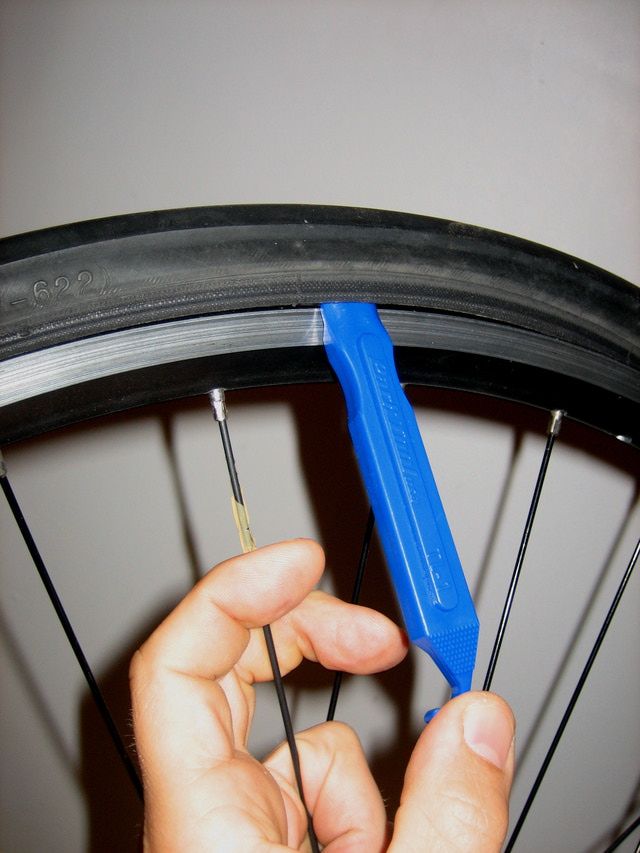
Inflate the tires to the pressure recommended by the automaker (a plate with recommendations is attached in the driver's door opening) and find the cause of the fall: puncture, cracks, hernia, nipple, rust on the disc rim in the place where the tire fits, etc.
Center wear
Tire pressure too high.
Reduce the pressure to the recommended (indicated on the tablet in the driver's doorway)
In the form of rings and furrows
can be found on trailers or rear wheels of pickups and vans due to vibrations and vibrations and vibrations due to vibrations and vibrations bouncing at high speeds.
Changing wheels on a loaded axle to equalize wear, driving with a heavier load.
Chipped wear with cuts
Frequent wheel spin on rocky surfaces.
Move the wheels to a non-driving axle, use the gas pedal more carefully when starting to move.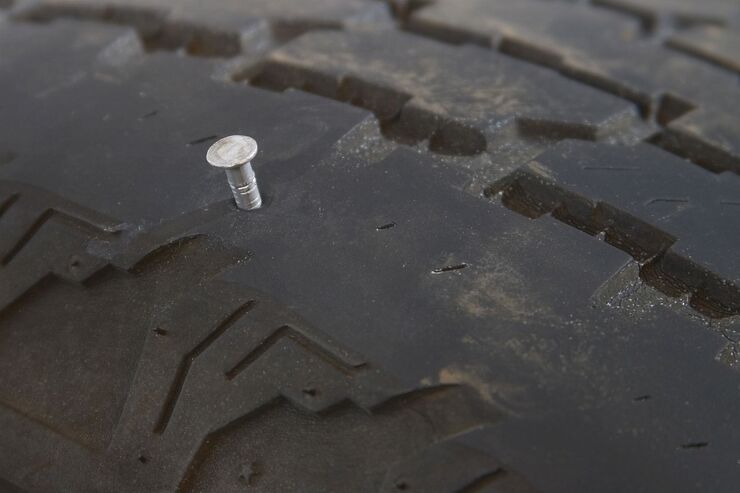
Photo: Petr Urbanek / Unsplash
Our new video
Consumption 2-3 l/100 km! Test of the most economical UAZ
Test of the earliest VAZ-2103 from the surviving
Test of a new crossover. Again "Chinese"? Not quite
Did you like the note? Subscribe and you will always be in the know!
Driving on Yandex.Zen
News smi2.ru
If you get a flat tire while driving, don't panic. Here's what to do:
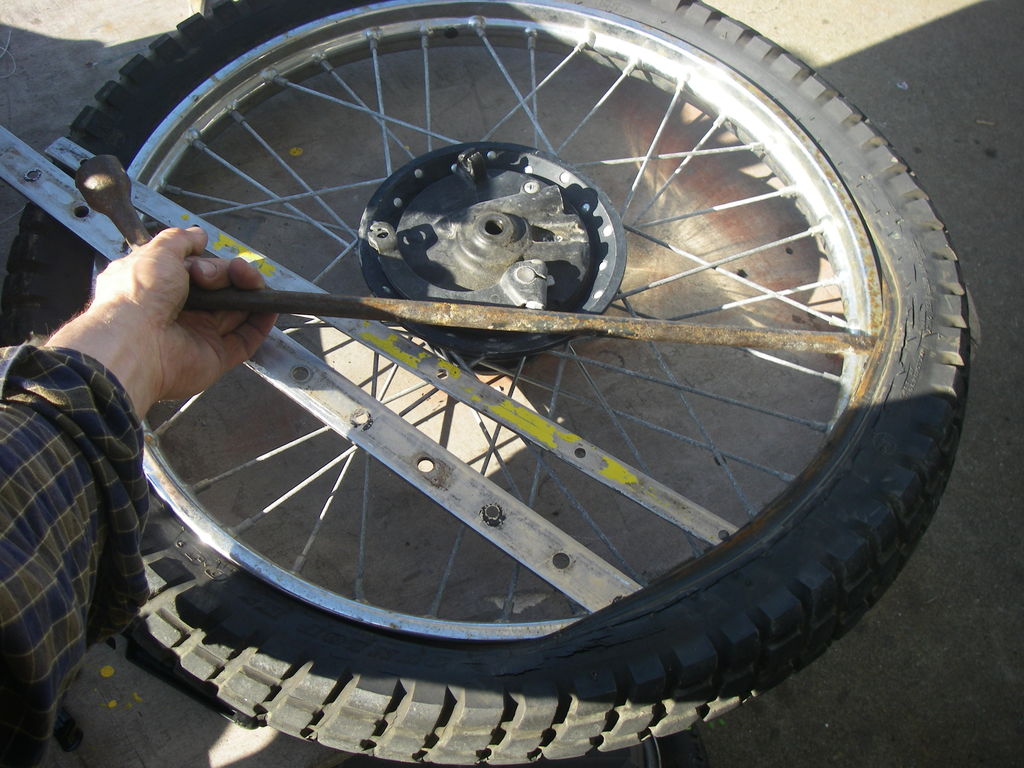 Make sure it is on a hard surface and not on any part of the exhaust system.
Make sure it is on a hard surface and not on any part of the exhaust system. Assuming you have a standard road bike:
3 . Slide the new tire onto the wheel, being careful not to damage or pinch the inner tube between the tire beads. Start by placing one side of the new tire on the edge of the wheel and work your way around until both sides of the tire are properly seated in the rim.
 Otherwise, you will need to use a wrench to loosen the nuts before removing the wheel.
Otherwise, you will need to use a wrench to loosen the nuts before removing the wheel. If you are stuck on the side of the road with a flat tire, there are several ways to get help. You can call a tow truck or roadside assistance, who will usually be able to change your tire. You can also ask a passing motorist for help, although this is not always safe. If you have a spare and know how to change it yourself, this is the best option. Otherwise, call for help and wait patiently for someone to arrive.
It is best to fix a flat tire the first time it happens. This will prevent tire deterioration and additional repair costs.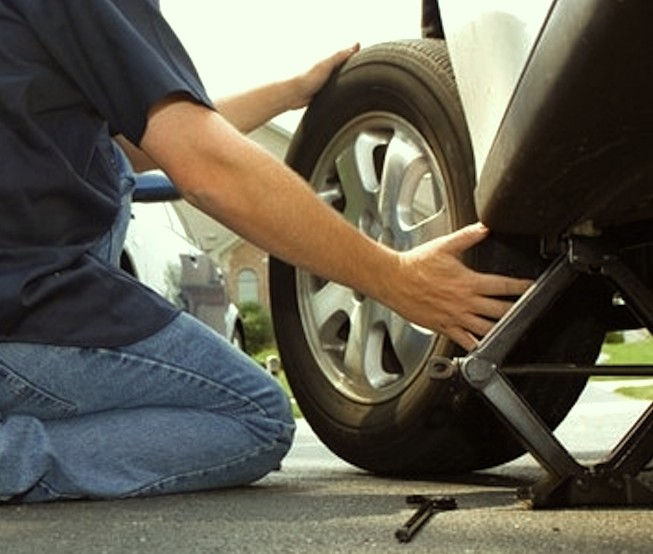
There are several reasons why tires deflate. One reason is a hole in the tire. Another reason is that the air pressure inside the tire is too low. The last reason is that something is blocking the valve stem, preventing air into the tire.
If you do not have a tire pressure monitoring system, it is recommended that you check your tires at least once a month. A quick way to do this is to use a penny test. Take a coin and insert it into the tire tread. If you see the head of Abraham Lincoln, then the depth you have less than 2/32 inch of tread and it's time to buy new tires.
If you drive with a flat tire, you may experience reduced fuel efficiency, uneven tire wear, and a harder ride. You may also damage a rim or tire if you continue driving on a level road. If you have a spare tire, it is best to change him as soon as possible.